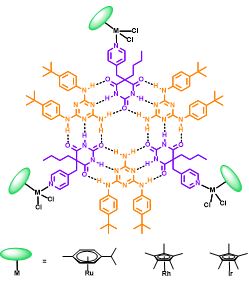Hydrogen Bonded Arene Ruthenium Metalla-Assemblies
Hydrogen bonds are the most utilized non-covalent interactions in biological systems, due to their directionality, stability, reversibility and diversity. The weak strength of hydrogen bonds can be modified by combining several hydrogen bonds in the same unit like in the melamine-cyanuric/barbituric acid rosette-type system.1
Arene ruthenium metalla-assemblies have showed great biological potential.2,3 Inspired by the combination of Hbonding and metal complexation from the group of de Mendoza,4 we have recently prepared a series of hydrogen bonded metalla-assemblies.5 Therefore, to further investigate hydrogen bonded metalla-assemblies, we used the melamine-barbituric rosette-type system with piano-stool complexes. The introduction of a pyridyl group on the barbituric acid moiety allows coordination of metals at the periphery of the rosette. New rosette-type metalla-assemblies have been prepared and fully characterized.

1. Mathias, J. P.; Simanek, E. E.; Zerkowski, J. A.; Seto, C. T.; Whitesides, G. M. J. Am. Chem. Soc. 1994, 116, 4316.
2. Therrien, B.; Süss-Fink, G.; Govindaswamy, P.; Renfrew, A. K.; Dyson, P. J. Ange. Chem. Inter. Ed. 2008, 47, 3773.
3. Mattsson, J.; Govindaswamy, P.; Furrer, J.; Sei, Y.; Yamaguchi, K.; Süss-Fink, G.; Therrien, B. Organometallics 2008, 27, 4346.
4. Marshall, L. J.; de Mendoza, J. Org. Lett. 2013, 15, 1548.
5. Appavoo, D.; Carnevale, D.; Deschenaux, R.; Therrien, B. J. Organomet. Chem. 2016, 824, 80.